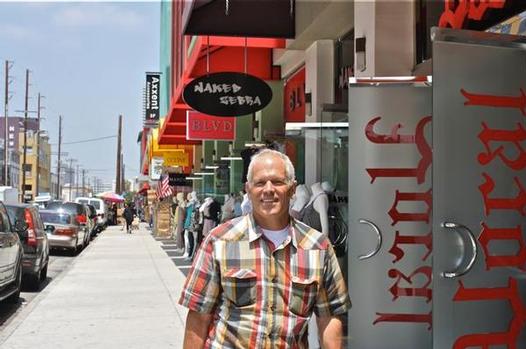Glik’s President and CEO Jeff Glik walked past storefront after storefront filled with everything a junior’s buyer needs: dresses, fashion tops, denim, jewelry, accessories, shoes.
The options are endless at the San Pedro Wholesale Mart in downtown Los Angeles, with stores spilling in every direction, down alleys and in covered buildings. Vendors literally wheel garments directly off factory floors into the storefronts, where buyers from retailers big and small scout what’s new, and what they can get in stores fast.
Jeff has a special credit card in his wallet with a $250,000 limit just for this occasion. By the time the week is through, he will have spent it all, snapping up the hottest styles of the moment to please the teenage girls that shop at Glik’s 52 stores in the Midwest.
There’s been a lot of talk about how fast fashion is hurting junior’s brands and industry retailers. This is a story about one retailer that is killing it in junior’s by embracing fast fashion.
Glik’s, headquartered in Granite City, Illinois, carries action sports brands, denim brands such as Miss Me and Big Star, and fashion brands such as BB Dakota. Glik’s business is 60% gals and 40% guys.
Glik’s began adding fast fashion to its merchandise mix 2 ½ years ago, after a retail colleague told Jeff about San Pedro, gave him a few vendor names, and urged him to get on a plane and check it out.
Today, fast fashion accounts for 50% of Glik’s young women’s tops business and positively impacts many facets of the company, Jeff said.
“We have faster turns, and better margins with fast fashion,” he said. “My margins are at historic highs – and we’ve been in business 113 years. … Fast fashion has dramatically increased foot traffic in our stores – we are the go-to store for fashion.”
Fresh from the factory floor
I tagged along with Jeff on his buying trip one day last week.
Most of the vendors we visited knew him, and were ready when he asked his trademark line: “What’s hot?”
Jeff had a lot to choose from at one of his best vendors in San Pedro, which he didn’t want to name. The fabrics this vendor uses are very innovative and trend-right.
“A lot of the surf people don’t get these fabrications, and if they do, they are a year behind,” he said.
He bought a wide range of goods to fill in for the last few months of summer and to help the stores transition to fall, including: a grey print chiffon dress for $9.75; a charcoal top with Dolman sleeves and banded bottom for $7.25; a sailor shirt with buttons for $6.50; a flyaway vest with a crochet back for $7.25.
Often, the salesman that handled Jeff’s order was on the phone with the factory to determine what the price of garments should be. The goods are made so fast – the owners often decide that morning what to cut and make based on what is selling – that prices are not yet set.
As Jeff was looking at garments and writing orders, a worker rolled a cart by. The cart was filled with a cute maxi dress for $11.75 that just arrived from the factory two blocks away in downtown Los Angeles.
“Isn’t this just mind blowing?” Jeff said, with a big smile.
What Jeff really loves is that the goods he buys will be shipped the same day. In fact, all through the area, there’s the rip, rip, rip sound of packing tape being unspooled and placed on boxes. Boxes of goods fill stores in the afternoon and line the sidewalks, waiting to be picked up by UPS.
When I tagged along with Jeff, he mostly bought small quantities of goods that he will test. Once he’s back home and the goods arrive in stores, Glik’s store managers send him emails if anything is moving fast. Then he’ll call his San Pedro vendors and rush in an all-store buy, and the vendors will ship the same day.
At each stop that day, vendors steered him to their hottest pieces – skinny cargo jeans ala J Brand for $14.75 at a denim shop where Jeff swears by the fit. A long, thick tan cardigan with a belt for $9 at another. Cute, lightweight, stylish jackets with buttons at one business that makes goods for Bebe. Crochet tops and vests at a small storefront that specialize in those styles.
Jeff also buys a lot of basics at San Pedro – tanks and T’s and bandeaus, including a 1,200-piece reorder of a neon tank.
One large, two-story storefront we stop in has every kind of accessory you can imagine, from hair clips to purses. It is so busy, it has 10 or so check out lanes, just like a grocery store.
Ideally, Jeff would like to come to LA every five weeks to ensure fresh goods of the hottest styles are constantly flowing to stores.
I was surprised that Jeff – the CEO of a 52-store chain – was pounding the pavement in LA. It’s not easy schlepping from vendor to vendor, sitting at tiny little tables crowded into stores, often managing language barriers – both Korean and Spanish.
He works very closely with Glik’s buying team, but is very hands on as well.
“To me, it’s all in the buy,” Jeff said. “If you don’t have great product, you aren’t going to do well.”
Challenges
While the prices are low, there are challenges to buying fast fashion, Jeff says.
It’s all cash and carry – buy now, pay now. The vendors don’t have much infrastructure.
“Sometimes its even hard to get them to write a PO number on the outside of the box,” he said. Also, they aren’t so good at handling future orders. Those tend to get lost because they don’t have good systems, he said.
However, this lack of infrastructure is also attractive to Jeff. Because they don’t have good systems, some of the vendors here are often too small to sell to department stores and big chains. Jeff said he hasn’t seen any of the brands he buys in the San Pedro area at his competitors’ stores.
“This is my differentiator,” he said.
Glik’s doesn’t have a private label line, and now Jeff doesn’t feel the need to start one.
“What’s my private label? These 300 people I deal with here are.”
Some say that there is not a consistent aesthetic with fast-fashion vendors, that it’s a very disjointed offering.
Jeff’s response: “Our customer – teenage girls – are very disjointed,” he said.
There is also no noticeable difference in quality between his fast-fashion vendors and his branded vendors, he said.
“I don’t have any more returns from my fast-fashion brands than other brands,” he said.
Brands valuable
Jeff stressed industry brands are still relevant in Glik’s, and some of the styles he bought this day would mean more to his customers if it had an industry label on them. He’ll sometimes share general trend information he’s gleaned from spending so much time in the fashion world with brands.
However, the margins in his fast-fashion business – 65% vs. the 50%-55% he can get with branded goods – are very appealing. As are the up-to-the-minute styles.
On the Glik’s store floor, the fast-fashion pieces are priced about 30% lower than branded goods.
“So the customer is getting better fashion and lower prices,” he said.
Jeff is going to the Agenda Trade Show next month, and he fully expects to see similar trends that he saw last week in downtown LA when brands show him their lines.
But those brands’ goods won’t be delivered until December and January – and who knows what will be in style then?
“I don’t want to make a decision in August about what is going to rock my world in January, February and March,” he said.
The future
Now that Forever 21 is moving into men’s, Jeff predicts more fast-fashion vendors will start making young men’s clothing.
“It’s got to happen,” he said. “Forever 21 (which uses LA vendors), will push these guys to get into it. It’s only a matter of time.”
For now, Jeff’s just thankful he found out about San Pedro, he said. His gals’ tops business, which accounts for 55% of all young women’s sales, rose 18% in June. For the first six months of the year, tops sales rose 15%.
Glik’s bottoms business, mostly name-brand denim, is up about half that amount. He attributes the increased sales in bottoms to the increased visits from young women looking for fashion tops.
“Our junior’s business is the best it has ever been,” Jeff said.
“I feel blessed we figured this out early in the cycle. Otherwise, we’d be singing the blues like everyone else.”






